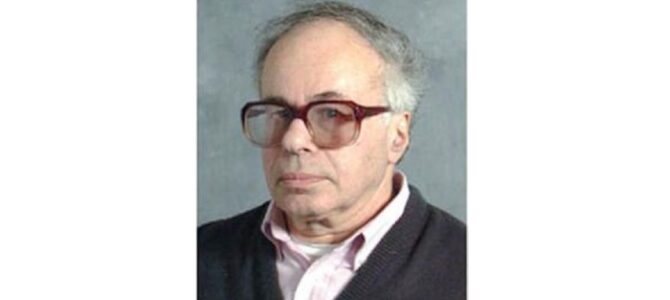Original article: obzor.lt, 2022-03-22
Translated from Russian to Lithuanian by Irena Miškinienė, and from Lithuanian to English by Geoff Vasil
My Teacher Joshua Levinson Would Have Turned 90 Today
by professor Pinchos Fridberg,
Vilnius
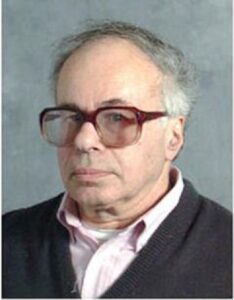
Joshua Levinson
In the place of an introduction
When you have reached the 80-year mark and have become an old and tired horse who can barely lift his hooves, and they take you funem yarid (Yiddish, “from the fair,” a formulation by the Yiddish writer Sholem Aleichem), the faces of your dearest and most beloved people appear before you ever more often, those who have left this world before you. My parents who gave me life. My Teachers who were sent by destiny.
* * *
The two of us became acquainted on the first day of my life as a university student. And this is how it was. At a meeting of freshmen to kick off the 1956 academic year, I, then a student of the Physics Faculty, accidentally found myself next to the cheerful and witty chemistry student Aneta. I won’t lie, we didn’t pay a lot of attention to what the heads of faculty were saying (we were only 18 after all), and mostly talked to each other about life. An hour passed without our noticing it, and we left together to go to our homes. One hundred meters from the building on Naugarduko street which housed the Chemistry and Physics Faculties then, we met a stocky, athletic young man with glasses. This was Aneta’s cousin. We got acquainted. I soon learned Aneta had lost her parents in the Kaunas ghetto and Joshua’s parents took care of her after that.
In my junior year I began attending an atomic spectroscopy seminar held in Vilnius. I can still remember now the rapt attention the members of the audience paid to every word uttered by Levinson.
* * *
I’ll begin with the most important thing: he was a good, just and moral man.
I won’t use words such as “exceptionally,” “greatly” or “extremely” here in this characterization. That is not accidental. Life has shown me that “goodness” cannot be measured in degrees, a person either has this quality, or does not. And nothing really needs further explanation here: a normal person understands what I mean.
He was a Good theoretical physicist.
Several of his Ideas have been entered in the annals of modern physics. Here I intentionally use the simple word “good” instead the more usual clichés “renowned,” “genial” or “great.” At no time is a Good physicist frequently encountered; the great mass are always comprised of the Average, the “worker bees,” without whose daily and painstaking work no Idea can ever come to fruition.
He was a natural-born Teacher.
He like no other person knew how to explain simply the most complex aspect of physics.
He was a person of Goodwill, completely without conflict.
The only people who were capable of not liking him were those who were infected by the virus of anti-Semitism and/or of jealousy for his talent.
These are the words from my article published in 2008 in four languages, Russian, Lithuanian, English and Yiddish:
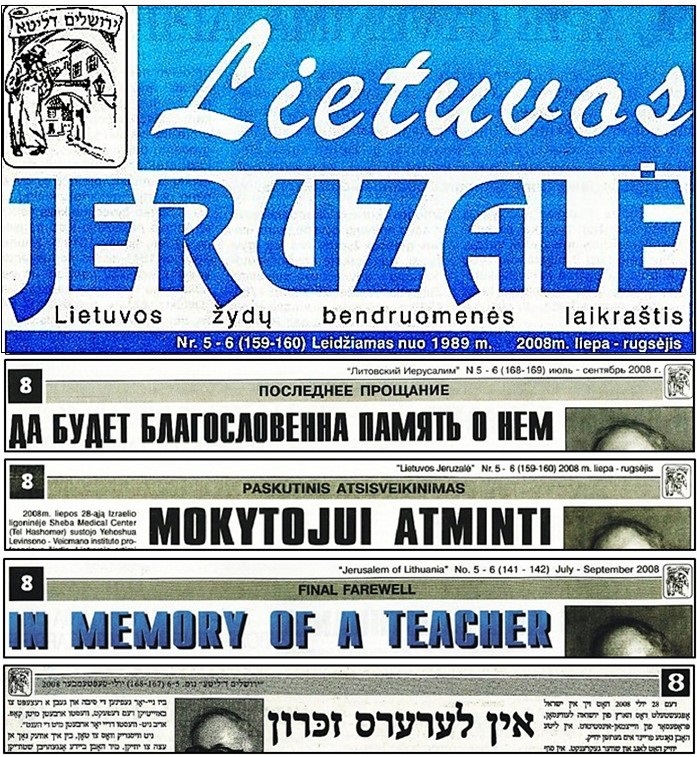
* * *
Move from Atomic Spectroscopy to Microwave Engineering
My alma mater is the theoretical physics cathedral of Vilnius University. My specialization was atomic spectroscopy. After graduating, I was appointed to a “mail box” [a secret facility]. I was happy I had avoided working as a physics teacher at a regular public school.
On August 1, 1961, I, filled with hope and aspiration, crossed the threshold of a special regime department. This department created microwave measurement equipment. The head of the department called one of the senior engineers at the laboratory into her office. She told him, “Here are your reinforcements!” and bid me farewell. This engineer took me into the lab, sat me down at a table in front of some sort of device and asked me if I was very familiar with microwave engineering equipment. I answered the question with a question: “What is microwave engineering?” Then he inquired if I had ever seen a soldering iron in my life. I nodded yes. Then the acting head of the laboratory swiftly placed a soldering iron in my hands and, ordering me to solder Teflon tubing for bolometric power meters, added: “The head of the lab will return from vacation in two weeks, let him worry about what to do with you.”
I gritted my teeth and began soldering. I cursed the whole world. Time passed torturously and slowly. Finally head of department Simon Solomonovich Fel came back from vacation. Without waiting much longer, I stated: “Either give me work according to my qualifications, or let me go.” His answer was this: “Recently at one [defense facility] in Kiev they began using an untunable echo resonator of spherical form [БЭР in Russian] to measure the power of radar stations. The radius of the sphere was 5 to 7 times greater than the wavelength. But a flaw appeared: at some frequencies it ‘doesn’t want’ to resonate. We were given the task of performing measurements, finding the source of the flaw and, if possible, to suggest a way to fix it. Here’s a real assignment for you: if you can figure out the source of the problem before the new year, you can go on working with your brain, but if not, you’ll have to do handiwork for the next three years [according to the Soviet labor laws at the time].”
Not knowing where to begin, I went to Yuzik for advice. That’s what the friends of Joshua Benyaminovich Levinson, the theoretical physicist working at the Lithuanian Academy of Sciences, lovingly called him. I got lucky: Juzik was interested by the problem. After discussing it, the two of us began studying microwave electrodynamics and over the course of four months we came up with a theory regarding the aforementioned resonator. Without going into fine detail, I will say the experiment completely confirmed the results of our calculations. Our calculations led to the mass production of a new device called the БЭР-636. And Yuzik became my teacher, even though he was only six years older than I was.
Levinson was one of the founders of the Vilnius school of microwave electrodynamics: from 1962 onwards and until his departure to Chernogolovka in 1968, he was the laboratory’s theoretical calculations consultant for the Vilnius Institute of Scientific Research on Radio Measurement Technology (his job there was a half-time position of senior scientific staff member). The school endured for almost 30 years, until the downfall of the Soviet Union. Over its lifetime laboratory workers published more than one hundred articles (Levinson was co-author on the first nine articles) which were published in the leading Soviet and American scientific journals (Proceedings of the USSR Academy of Sciences, Union of Soviet Socialist Republics, Radio Engineering and Electronic Physics, Radiophysics and Quantum Electronics and Technical Physics on the Soviet side (aka Доклады Академии наук СССР, Радиотехника и электроника, Известия ВУЗов, Радиофизика, Журнал технической физики) and IEEE Transactions on Antennas and Propagation, IEEE Transactions on Microwave Theory and Techniques and the Microwave Journal on the American side).
* * *
The first half of Yuzik’s life is connected with Lithuania. I would like to talk about this half. To tell that story, calling things by their true names.
Juzik was born in Kaunas on March 22, 1932. As is well known, almost all Jews from Kaunas perished in the flames of the Holocaust. Juzik was saved by his parents who miraculously managed to flee deep into Russia. Immediately after the war the family returned to Lithuania and in 1949 he, an academic gold-medal winner, managed to matriculate at the most prestigious institute of higher eduction in the USSR, the Moscow Engineering and Physics Institute (commonly known by the acronym MIFI, now aka Moscow State Engineering Physics Institute).
Soon the 31-year-old professor Veniamin Levich, a student of the academicians Lev Landau and Aleksander Frumkin, noticed and paid attention to this talented student with his non-trivial way of thinking and interest in scientific work. Levich was the founder of physicochemical hydrodynamics and a correspondent member of the Soviet Academy of Sciences (1958) who later become such an active fighter for the rights of Jews in the Soviet Union. But this duo was not destined to happen. In 1953 during the “doctors’ plot” Yuzik, a student who only earned the highest marks, was kicked out of the MIFI without explanation and sent to the Institute of Tractor Manufacturing as “reinforcements.” For weeks on end Juzik trod tirelessly the corridors of the Soviet Ministry of Higher Education and finally managed to get appointed to Gorky University [now Nizhniy Novgorod]. After the war a strong school of physics formed there, made up of evacuated and exiled scientists. Had he gotten lucky? Not really. A scrupulous “director” in the personnel department there soon discovered the number of [required] academic hours for English language at MIFI was six (six!) hours fewer than at Gorky University. And so he was forced to leave Gorky.
Yuzik came back to Vilnius. This happened near the end of spring in 1953. The student driven out of Moscow was also not accepted at Vilnius University. Having lost hope, Yuzik’s father went to his friend for help, deputy director of the construction trust Yosif Tinovsky. And here we can talk about a situation wherein the influential people you knew apparently trumped state-driven anti-Semitism: Yuzik was admitted into the fourth year of the Physics and Mathematics Faculty at Vilnius University. Yuzik amazed and astonished his teachers with his knowledge to the extent that the newspaper Tarybinis studentas [Soviet Student] published his photograph under the headline “The University’s Best People” in November of 1953.
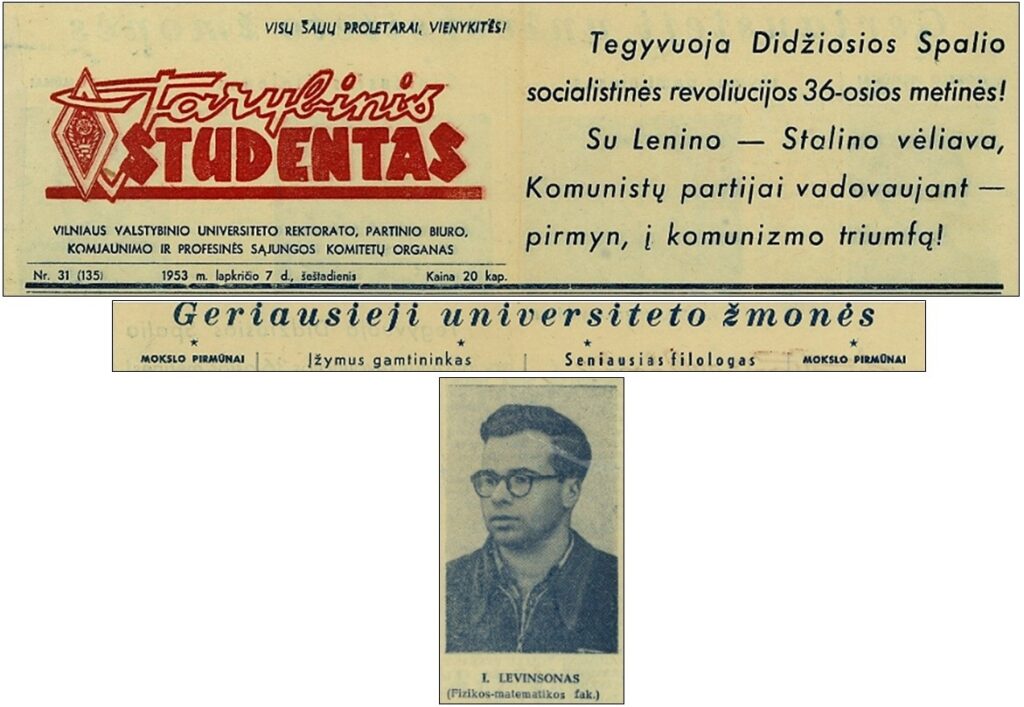
After being graduated from university, Yuzik received notice he was conscripted into the army. Private Levinson of the 16th Lithuanian Division over the course of his two years of service managed to think up and write three academic articles on problems in atomic spectroscopy. They were submitted to Works of the Physics and Technology Institute of the Soviet Lithuanian Academy of Sciences [Lietuvos TSR MA fizikos ir technikos instituto darbai] and Works of the Academy of Sciences of the Lithuanian Soviet Socialist Republic [Lietuvos TSR MA darbai]. They were published in 1957 and 1958 and they quickly became classics, setting for decades to come the choice of topics for dissertations by Lithuanian theoretical physics candidates and doctors [in the Soviet academic system academics with doctorates could go one further and become an habilitated doctor–translator].
Lev Landau and Evgeny Lifshitz cited these “soldierly” works by Levinson in the third volume of their “Course in Theoretical Physics” which became the Bible for physicists throughout the world (see: Квантовая механика (нерелятивистская теория), М.: Наука, 1963, второе издание).
A Few More Words about This Sensational Citation
I first learned of this source before the aforementioned second edition appeared. This happened at the very beginning of the 1960s at a seminar on atomic spectroscopy held in Vilnius. When I. Shapiro from Moscow, a correspondent member of the Soviet Academy of Sciences, spoke there, he learned Levinson was in the audience, and said loud enough for all to hear: “Landau included your result [meaning the diagrammatic method for adding the Wigner and Racah coefficients] in the second edition of his ‘Quantum Mechanics.’ This book is currently being prepared for publication.”
Citation of Levinson’s results in the “cult textbook by Landau and Lifshitz” was also mentioned in an article by a group of professors from Israel’s Weizmann Institute published in Physics Today.
It’s a known fact that Nobel prize winner Lev Landau provides very few footnotes in his works. The reason is very simple: this researcher found it much simpler and quicker to get the needed result himself, without wasting time looking for it in the literature. That the reader not steeped in theoretical physics might understand correctly the “coolness” of Landau including this citation in his work, I present here a photocopy of a passage from E. Lifshitz’s introduction to the third edition of Quantum Mechanics (1974):
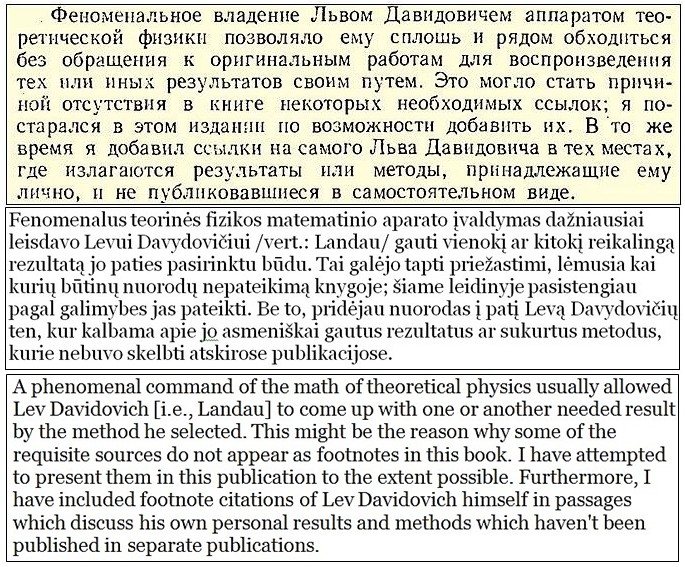
Lyrical Deviation
A comment appeared under my article published in 2017 by the international magazine Мы Здесь [We Are Here] based in Israel:
Guest | 2017 04 03 05:40
“As I recall, Joshua Benyaminovich was born here in Haifa. Before World War II he and his parents travelled to Lithuania to visit relatives. There the war overtook them, the USSR invaded Lithuania, and they weren’t able to return.
“Furthermore: the MIFI rector, it seems, didn’t want to throw the great student out and, when he encountered him at the institute, he pretended he hadn’t seen him.
“In the army Joshua Benyaminovich was ordered to help his senior officer (I don’t remember his rank) earn a high-school diploma, it seems. His job was called ‘head of correspondence’ and he used to speak about this with his characteristically gentle humor.”
Understandably, I quickly replied to Guest:
autorius | 2017 04 03 22:40
to: Guest | 2017 04 03 05:40
“It’s a shame you didn’t say who you are.
“Concerning Yuzik’s birth in Tel Aviv (not Haifa), I heard that long ago. Besides which, I knew his parents had their own pardes [citrus grove]. Nonetheless, Yuzik’s documents indicated his place of birth was Kaunas.
“I hadn’t heard the story about the MIFI rector.
“About his military service, you are correct: he was a clerk (due to poor eyesight). Yuzik used to tell me the story of his military service and I remember it well.
“This senior officer was the commander of unit headquarters lieutenant colonel Pshenko. He was enrolled in evening school correspondence courses based in the officers barracks of the garrison. Yuzik’s friend Ima [Emanuil] Levitan taught physics there, but Yuzik didn’t know that.
“All of the distance learners, and most of them were combat officers who were veterans of World War II, received pages with homework assignments. Once every two weeks they turned in their assignments, presenting their notebooks with solutions to the problems to the teacher.
“Pshenko, who had no knowledge of physics, always received very good marks for his solutions. Seeing this, Ima began assigning him more difficult problems. Pshenko nonetheless solved the problems very well. In the end, Ima began giving him assignments from the set of problems from the Zubov’s [Academic] Olympics book, and continued to get the correct answers back in the notebooks turned in.
“The end of the story is this. Once Pshenko didn’t have time (or perhaps was too lazy) and didn’t write the solved problems down in his notebook, but simply handed in Yuzik’s notebook, the handwriting of which was beautiful and very clear.
“Of course Ima recognized immediately this was Yuzik’s handwriting…
“When they met they both laughed very hard about it.”
* * *
I will allow myself to publicize one little-known fact which I witnessed. In early 1958 the authoritative journal Advances Physical Sciences [Успехи физических наук] asked Levinson to submit a long article. The article was written but never saw the light of day because… it wasn’t approved for publication by “the director.” After that Levinson drastically changed the direction of his scientific interests and chose solid-state physics instead, and pursued it for the rest of his life.
From 1957 till 1966 Yuzik worked at the Physics and Mathematics Institute of the Academy of Sciences of the Lithuanian Soviet Socialist Republic, and for two years after that at the Semiconductor Physics Institute of the Academy of Sciences of the Lithuanian Soviet Socialist Republic.
This well-known theoretical physicist didn’t even have a laboratory at any of these institutions, and was never nominated to become a member of the Lithuanian Academy of Sciences.
Not wanting to offend my colleagues, I will nonetheless allow myself to say that in terms of level of scientific research, no theoretical physicist in Soviet Lithuania even came close to the level of work by Levinson. Those who disagree with me are welcome to cast a stone at me. I won’t be offended! But before casting that stone, I suggest you take a look first at the Citation Index (the index for citing academic works), or use a similar source.
In 1968 Levinson received the offer to work at the L. Landau Theoretical Physics Institute (ИТФ) of the USSR Academy of Sciences. He accepted the offer and left Lithuania forever.
Forty years later one of his colleagues commented upon the situation like this: “This invitation made the same sort of impression as if a soldier in a far-flung colonial garrison had been invited to the King’s Guard.”
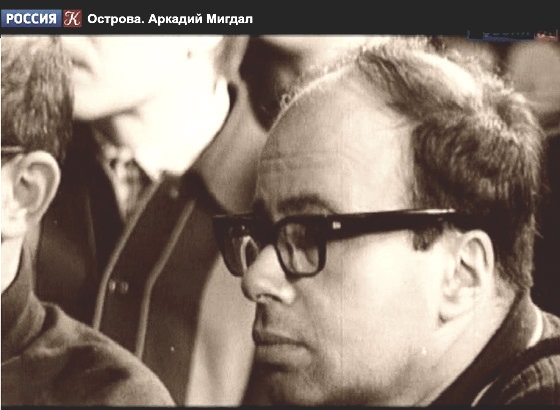
Joshua Levinson at the L. Landau seminar. Frame from the film “Islands. Arkady Migdal” [Острова. Аркадий Мигдал] shown on the “Culture” program of the RTR [РТР] television channel.
In 1985 Levinson was appointed to head the theoretical department of the newly-established Micro-Electronics Technology Problems Institute of the Academy of Sciences of the USSR.
In 1992 he was invited to work at the Weizmann Institute in Israel for a half-year. He never returned to Chernogolovka after that. This is what Konstantin Kikoin has to say about that in his interesting article “Mathematics and Physics in the Aliyah of the 1970s-1990s of the Twentieth Century” [Математики и физики в алие 70-х – 90-х годов ХХ века]:
“All the Israeli universities opened wide their gates to the pioneers of the great aliyah of physicists in the early 1990s. Physicists received the Barecha and Guastalla scholarships and were accepted at Tel Aviv University, the Technion and Hebrew University in Jerusalem. The Weizmann Institute together with the L. Landau Theoretical Physics Institute organized a long-term program of research to be carried out, and after its conclusion several professors from Russia were offered professorships in Rehovot…
“In the history of the best Israeli research center–the Weizmann Institute–these ‘former compatriots’ represent a rather large group of physicists. This fact says much about the quality of the Russian scientific aliyah, since only those researchers meeting the highest international standards were admitted individually into the institute’s physics department. Among the Russian-speaking staff, Arkady Aronov (1939-1994) and Joshua Levinson (1932-2008) merit first mention…
“J. Levinson began his scientific career in Vilnius. It’s noteworthy he earned the name of scientist through his works on solutions to the problems of angular momentum theory. Founder of the Israeli theoretical school Giulio Racah is considered the father of this theory. In the mid-1960s Levinson was invited to the newly-established L. Landau Theoretical Physics Institute. There in Chernogolovka he participated in a joint Theoretical Physics Institute/Weizmann Institute program, after which he was accepted by the Weizmann Institute to work in the VATAT program, and quickly became involved in mesoscopic structures research, publishing dozens of articles equal or better in quality than his work at Chernogolovka. He received the prestigious Alexander von Humboldt scholarship for remarkable researchers in 1996.
“The Israeli physicists community believe that, in terms of the older generation of physicists, Levinson probably represents the most successful example of absorption [integration].”
Yuzik was a professor at the Weizmann Institute until his final days (he passed away July 28, 2008). The significance of his life was summed up succinctly in a phrase delivered at his funeral:
“Levinson’s humble office became the Mecca for physicists who needed help and support.”
After becoming a widower, Yuzik had in Israel an opportunity not just to begin a new scientific life, but also to forge a new family. In January of 1993 he married Natasha.
Yehoshua Levinson (in English he was I. B. Levinson but later became Y. B. Levinson; in the early 1990s he changed the orthography of his given name from Ioshua to Yehoshua) is the author or co-author of more than 200 academic articles and three monographs. A list of his 145 published works until his departure for Israel in 1992 is available on the Theoretical Physics Institute’s webpage, and the other 57 can be found at scholar.google.com
Levinson supervised the defense of about twenty dissertations.
His works on problems in semiconductor physics received the USSR State Prize in 1987 and the Alexander von Humboldt Fund prize in 1996.


